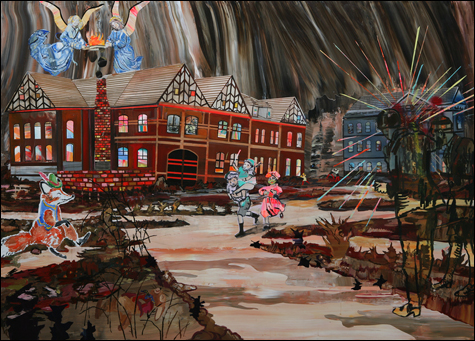Apocalyptic dread in the galleries
By GREG COOK | January 14, 2008

that is the national mood these days. |
“Strangefolks: John Copeland, Logan Grider, Elizabeth Huey”
Allston Skirt Gallery, 65 Thayer St, Boston, | Through February 16
“Langdon Graves: Preparations” and “Holly Coulis: Some People”
LAmontagne Gallery, 555 East 2nd St, South Boston | Through February 8
“Alexander DEmaria and Natasha Bowdoin: Myths and Fables”
Julie Chae Gallery, 450 Harrison Ave, Boston | Through January 26 |
An ill wind blows through Elizabeth Huey’s There’s a Boarded Bird Chirping Way Past Two (2008), part of a three-person exhibit of narrative paintings titled “Strangefolks” at the Allston Skirt Gallery (which is co-owned by Phoenix “Museums & Galleries” columnist Randi Hopkins). Three children lope down what appears to be a muddy path through a campus of institutional-type buildings. One child rides piggyback on another. The third kid, who seems to be wearing a muzzle mask, holds reins attached to one of the other’s pants. Behind them, the windows of a building are alight with ominous fluorescent energy, Renaissance-style angels collect smoke from a chimney into what might be a flaming crown, fluorescent rays explode out from another building, and little figures dash about in apparent terror. The black-brown sky seems to have melted, or maybe it’s the Northern Lights. A pair of transparent men watch the action from the foreground. And in the muddy rusty autumnal scrub at left, a fox, who could have been imagined by Richard Scarry, sits on a log and a smiling rabbit lies in brambles.As in a nightmare, the individual pieces have an evident order, and here and there they connect up to particular worries, but they never resolve into an overall message. Some have compared Huey’s mysterious narratives to those of “outsider” artist Henry Darger. Perhaps it’s illuminating to know that Huey, who lives in New York, has said that in her youth she spent time in a psychiatric institution, or that she used to worship as a Southern Baptist. Or maybe not. Either way, the portents look bad.
“Strangefolks” radiates an abject anxiety that is the national mood these days. We’ve had a pretty crappy millennium so far: September 11, wars in Afghanistan and Iraq (the latter hits its fifth anniversary in March), torture carried out in our name, a steady thumping of terrorist attacks abroad, Hurricane Katrina, global warming, and lately the mortgage crisis and threats of a looming economic recession. All this gloom and doom has burrowed down deep into our common dreams, mutated, and burbled back up in art as disconcerting symbols and off-kilter apocalyptic allegories.
Goth gloom is, of course, entertaining no matter the occasion, and at this particular juncture it feels apt and meaningful as well. But what makes “Strangefolks” an extra thrill is all the big, fresh, juicy painting going on here. Huey’s style is a charismatic variation of the popular Lucky Charms mode, which is recognizable by its glam fluorescent hues and patterns of hearts, stars, diamonds, and rainbows. And her scenes have an intriguing collaged-together look. That’s partly because she mixes hard-edged graphics with loose painterly passages, as well as flat and spatial modeling. But it’s mostly because she paints with stencils or masks out areas (or something like that), and this allows her to build up turbulent spots as thick and chunky as cake frosting but with edges so crisp that her designs appear pasted on.
 Related
Related:
Cannibals and castaways, Painting the end of the world, Mortification of the flesh, More 
- Cannibals and castaways
Dana Schutz flirts with the ugly, considers our condition, pictures the unimaginable, and uncovers what some might prefer left under a rock.
- Painting the end of the world
Back in 2001, the artist Dana Schutz had the deliciously harebrained idea to paint “The Last Man on Earth.” She named him Frank.
- Mortification of the flesh
“Global Feminisms” at Wellesley College’s Davis Museum could be one of the most important exhibits of the year.
- Painting the end of the world - side
- Shuffle mode
The news of the Allston Skirt Gallery closing turned out to be the first sign of a major gallery shake-up involving a number of Boston’s most prestigious venues.
- Wizards and masterpieces
At “Harry Potter: The Exhibition” at the Museum of Science, when a robed attendant places the sorting hat on a visitor’s head and soon after a door whooshes open to reveal the Hogwarts Express, you find yourself filled with the kind of giddy expectation you feel when getting your hands on a Potter book the day it’s released.
- Bodies and souls
Preserved flayed corpses at the Museum of Science, Americans in Paris at the Museum of Fine Arts, underground art at the Rhode Island School of Design Museum, beavers at Mass College of Art — it was that kind of year, capped off by the arrival of the new Institute of Contemporary Art.
- The devil in the details
It’s hard to imagine stopping to look at drawings that don’t coalesce till you let them pull you in and spin you around a bit.
- Flora, fauna, and the female figure
The Art Nouveau movement of the late-19th/early-20th century distanced itself from the mass production of the Industrial Revolution with elaborate, one-of-a-kind works made from unusual materials.
- Chihuly lite
The main problem with “Chihuly At RISD,” on view at the RISD Museum’s new Chace Center (through January 4), is that there’s not enough Dale Chihuly here.
- Worth another look
In 2008, real estate and jobs dominated local art news.
- Less

 Topics
Topics:
Museum And Gallery
, Henry Darger, Boston's Museum School, David Lynch, More  , Henry Darger, Boston's Museum School, David Lynch, Painting, Visual Arts, Institute of Contemporary Art, Dana Schutz, Alexander Demaria, John Copeland, Claes Oldenburg, Less
, Henry Darger, Boston's Museum School, David Lynch, Painting, Visual Arts, Institute of Contemporary Art, Dana Schutz, Alexander Demaria, John Copeland, Claes Oldenburg, Less 